By September 2024, about 19.5 million bitcoins have been mined. This leaves only 1.2 million bitcoins left to mine. This shows how fast the crypto mining world is growing. It’s a great time for newbies to jump into this field.
In this guide, we’ll give you the key tips and strategies for crypto mining in 2024 and later. You’ll learn how to start and succeed in this exciting field.
Key Takeaways
- Cryptocurrency mining is the process of validating transactions and creating new coins using powerful computers to solve complex puzzles.
- The guide covers essential equipment, software, and economic factors for successful crypto mining in 2024.
- Readers will learn about solo, pool, and cloud mining options, as well as profitability, hardware choices, energy costs, and regulatory considerations.
- Understanding the fundamentals of crypto mining will help readers make informed decisions about whether it’s a viable venture for them.
- The guide provides a roadmap for beginners to navigate the competitive and evolving crypto mining landscape.
Understanding Crypto Mining Basics
Crypto mining is key to the cryptocurrency world. It keeps blockchain networks safe and running. Powerful computers solve puzzles to confirm transactions and add them to the blockchain. This process secures the network and introduces new coins.
What is Crypto Mining?
Crypto mining verifies and adds new transactions to the blockchain. Miners use computers to solve complex puzzles. The first to solve gets cryptocurrency rewards. This keeps the network safe and releases new coins.
How Does Blockchain Work?
Blockchain is a digital ledger that records transactions securely and openly. Each block in the chain has many transactions. When a new block is added, it becomes part of the permanent record. This makes the network safe from single control and hacking.
Different Mining Types
- CPU Mining: Uses the computer’s CPU to solve puzzles.
- GPU Mining: Uses the GPU for faster and more efficient mining.
- ASIC Mining: Specialized hardware for top performance and energy use.
- Cloud Mining: Rents computing power from mining facilities, no need for hardware.
- Mining Pools: Miners pool resources for better chances of mining a block and sharing rewards.
Understanding crypto mining basics is key for beginners. Knowing the different mining methods helps find the best fit for resources and needs.
| Mining Method | Efficiency | Hardware Cost | Energy Consumption |
|---|---|---|---|
| CPU Mining | Low | Low | Low |
| GPU Mining | Medium | Medium | Medium |
| ASIC Mining | High | High | High |
| Cloud Mining | High | Varies | High |
How Encrypted Blockchain Transactions Keep You Safe
Choosing the Right Hardware
Choosing the right hardware is key to successful crypto mining. There are two main types: ASICs and GPUs. Each has its own benefits and things to consider.
ASIC vs. GPU Mining
ASICs are made just for mining and work better than GPUs. They use less energy and are faster. Big mining operations often choose ASICs like the Bitmain Antminer series.
GPUs are good for many tasks, not just mining. But they’re not as good for Bitcoin mining as ASICs.
Recommended Hardware Options
The Bitmain Antminer S19 Pro and MicroBT Whatsminer M30S++ are top picks. They have a great mix of speed, energy use, and cost. They’re favorites among both serious and casual miners.
Factors to Consider
- Hash rate: This is how fast the hardware can solve mining problems.
- Energy efficiency: This affects how much money you make from mining.
- Cost: You need to think about the initial cost and ongoing expenses.
- Lifespan: How long the hardware will last before it’s outdated.
By looking at these factors and picking the right crypto mining hardware, you can improve your mining success.
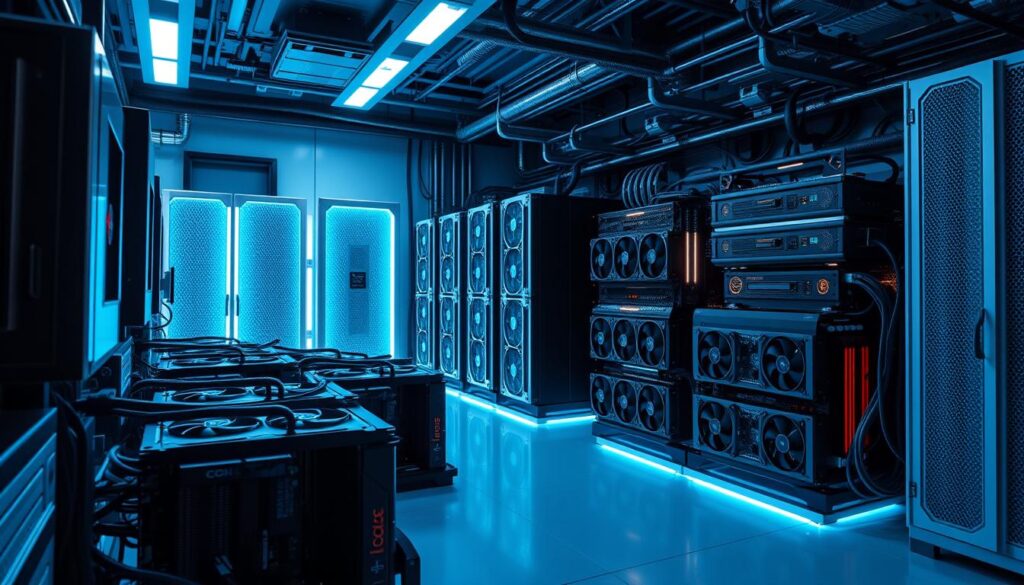
Selecting Mining Software
Getting into crypto mining can seem tough, but the right software makes it easier. There are many crypto mining software options to look at.
CGMiner and BFGMiner are open-source and support many mining devices. They have lots of features and can be customized. But, if you’re new, user-friendly mining interfaces like EasyMiner are better. EasyMiner has a simple interface and works with both ASIC and GPU, perfect for beginners.
Cloud mining services are also worth checking out. They let you rent mining hardware online. These services often have their own mining pool software, making mining easy for those without their own gear.
| Mining Software | Key Features | Ideal For |
|---|---|---|
| CGMiner | Open-source, supports wide range of hardware | Experienced miners |
| BFGMiner | Open-source, customizable mining parameters | Advanced users |
| EasyMiner | Graphical interface, supports ASIC and GPU | Beginners |
| Cloud Mining Services | Rent hardware remotely, integrated mining pool | Users without own equipment |
Choosing the right crypto mining software is key. Look for user-friendly mining interfaces to make mining smoother. This way, you can improve your mining success.
Setting Up a Mining Rig
Starting a crypto mining operation requires a solid setup. You need to pick the right hardware and configure the mining software. Here’s a guide to help you set up a top-notch mining rig.
Step-by-Step Setup Guide
Building a mining rig might seem hard, but it’s rewarding. Follow this step-by-step guide to set up your crypto mining rig:
- Choose your hardware: Pick a strong GPU like the GIGABYTE GeForce RTX 3060 Ti. Or go for an ASIC miner like the ASRock H110 Pro BTC+ motherboard. Add a high-performance CPU like the Intel Core i9-10900X.
- Assemble the rig: Mount the motherboard, install the CPU and RAM, and connect the power supply. Add USB riser cards and secure the GPUs or ASIC miner.
- Configure the BIOS: Adjust BIOS settings for better mining performance. This includes System Agent Configuration and more.
- Install the operating system: Set up Windows 10 and get the latest Nvidia drivers.
- Choose your mining software: Look at options like NiceHash and Ethermine. Find the best one for you.
- Join a mining pool: Boost your earnings by joining a good mining pool, like Antpool.
- Monitor and maintain your rig: Watch your rig’s performance, electricity use, and temperature. This keeps it running well.
Common Pitfalls to Avoid
When setting up a mining rig, watch out for common problems. These can make your operation smoother and more successful. Some issues to avoid include:
- Underestimating power requirements: Ensure your electrical setup can handle your mining gear’s power needs.
- Inadequate cooling: Mining rigs get hot. Make sure you have good cooling solutions.
- Choosing incompatible software: Pick mining software that works with your hardware and mining pool.
- Lack of security measures: Protect your mining rig and assets with strong security.
By avoiding these pitfalls and following the guide, you’ll set up a reliable and profitable mining rig in 2024.
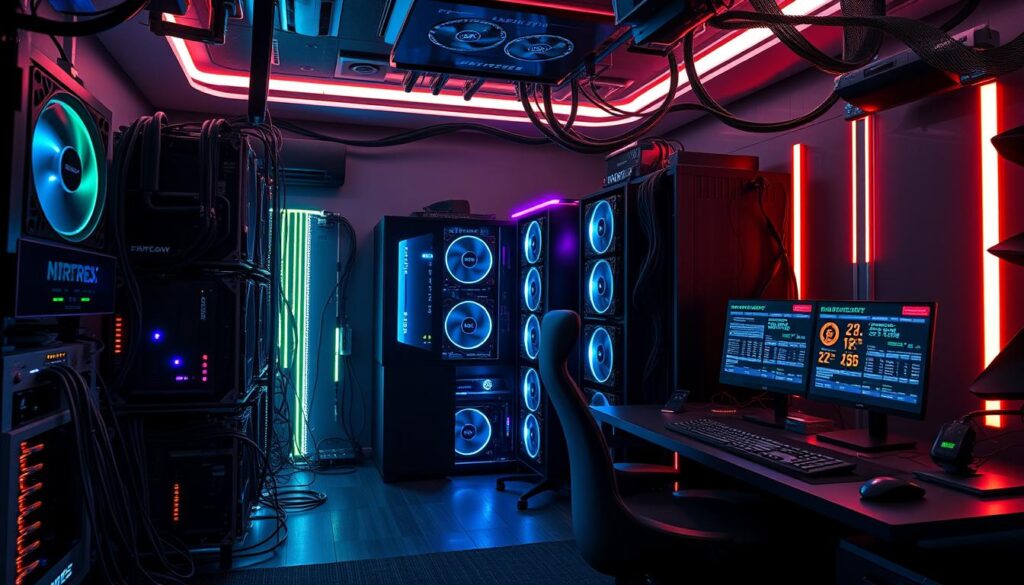
Joining a Mining Pool
Have you thought about joining a mining pool? Crypto mining pools let miners work together. This way, they can solve puzzles and earn rewards more easily. It’s a great way to get steady payouts, even if you don’t have a lot of resources.
Benefits of Mining Pools
- Consistent payouts: Mining pools give you a steady income, unlike solo mining which can be unpredictable.
- Increased mining power: Working together, miners in a pool have a higher chance of solving puzzles and earning rewards.
- Accessibility for small-scale miners: Even those with limited resources can join and help with mining.
Key Factors in Choosing a Pool
Choosing the right mining pool is key. Look at the pool’s size, how it pays out, its fees, and its reputation. Pools like F2Pool and AntPool have different fees, ranging from 1% to 3%.
Choose a pool with a good reputation, clear operations, and reliable payouts. Also, consider how often it pays out. By looking at these factors, you can find a crypto mining pool that fits your goals and boosts your pool mining benefits.
Managing Electricity Costs
Electricity costs are a big deal in crypto mining. To keep your mining profitable, it’s key to know how to figure out your costs. Also, finding ways to use less electricity is important.
Calculating Your Mining Costs
To figure out your mining costs, think about your hardware’s power use, local electricity prices, and mining rewards. For instance, a 12-GPU rig might use 4 kWh, while a Bitcoin ASIC Antminer S19j XP might use 3.3 kWh. The cost depends on your area’s electricity rates.
Tips for Reducing Electricity Usage
- Invest in Energy-Efficient Hardware: Pick mining rigs and ASICs that use less power. Look for ones with low watt-per-hash ratios.
- Optimize Cooling Systems: Use smart cooling, like liquid systems, to manage heat better and cut down on electricity use.
- Utilize Off-Peak Electricity Rates: Use cheaper electricity during off-peak hours to lower your mining costs.
- Embrace Renewable Energy: Use solar panels or other green energy to power your mining. It cuts costs and carbon footprint.
- Maintain Hardware Regularly: Keep your mining rigs in good shape. This helps them stay efficient and work well over time.
By managing your electricity costs well and using energy-efficient methods, you can make more money from crypto mining. Keep an eye on cryptocurrency prices and mining difficulty. They change, so you need to check your mining efficiency often.
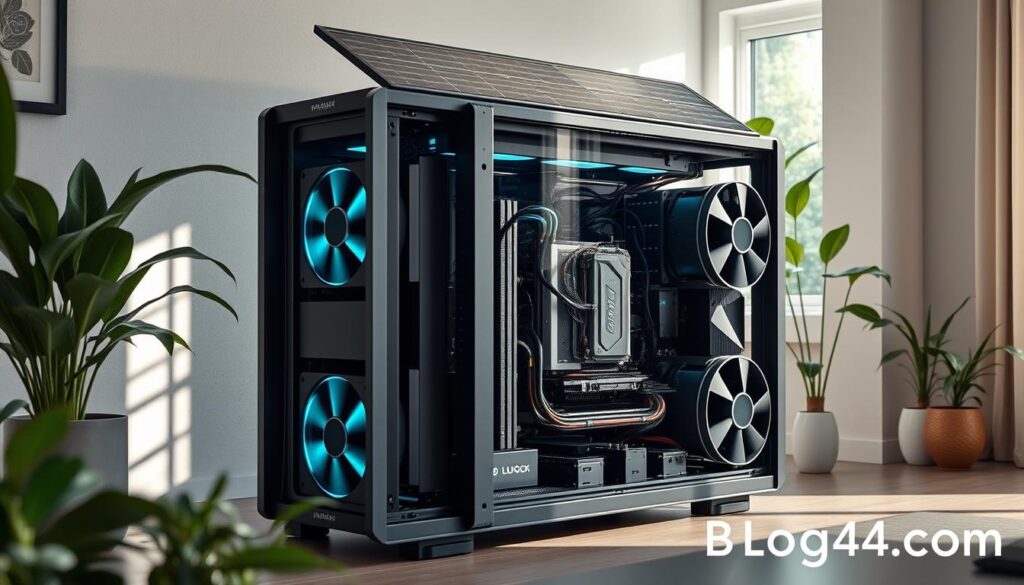
“Electricity costs are the biggest challenge for crypto miners, but with the right strategies, you can significantly reduce your power consumption and boost your bottom line.”
Monitoring Your Mining Performance
To stay profitable in crypto mining, you need to watch your mining performance closely. Tracking key metrics and using the right tools helps you mine better. This way, you can make sure you’re getting the most out of your mining setup.
Key Metrics to Monitor
- Hash rate: This shows how much work your mining rig does. It helps spot any problems or issues with your hardware.
- Power consumption: It’s important to know how much power you use. This helps keep costs down and efficiency up. Look for ways to use less power.
- Mining rewards: Keep an eye on what you earn from mining. This tells you if your mining is making money.
Crypto Mining Monitoring Tools
There are many tools to help you track your mining. Some popular ones are:
- MinerStats: It gives you live data on hash rates, power use, and earnings.
- Awesome Miner: This software lets you monitor and manage your mining remotely. It also helps optimize performance and sends alerts.
- Mining pool-provided tools: Many pools have tools to help you track your mining there.
These tools help you keep an eye on your crypto mining performance. They show you where to improve and help you make better choices. Regular mining monitoring is key to success in crypto mining.
Keeping Your Mining Secure
In the world of crypto mining, security is key. Protecting your mining from threats is vital. This ensures your mined assets and mining setup stay safe. Follow best practices and use recommended software to boost your mining security.
Best Practices for Security
- Use strong, unique passwords for all mining accounts. Enable two-factor authentication (2FA) for extra protection.
- Keep your mining software and systems updated. This ensures you have the latest security patches and bug fixes.
- Avoid mining on personal computers or public Wi-Fi. They can lead to malware and unauthorized access.
- Implement separate guest access on your router. This isolates your mining from other devices on your network.
- Watch your mining operations for any suspicious activities. Unexpected performance changes could signal a security breach.
Recommended Software Solutions
To enhance your mining security, consider these software solutions:
- Antivirus and Firewall Programs: Install reputable antivirus and firewall software. This helps detect and prevent malware, and blocks unauthorized access.
- Hardware Wallets: Use hardware wallets like Ledger or Trezor. They offer the highest security for your digital assets.
- Monitoring and Alerting Tools: Use mining-specific monitoring and alerting tools. They track your mining performance, detect anomalies, and alert you to security issues.
Keeping your crypto mining secure is an ongoing task. Stay alert, update your systems and software regularly. Use recommended best practices and software to safeguard your mining investments. This ensures the long-term success of your crypto mining efforts.
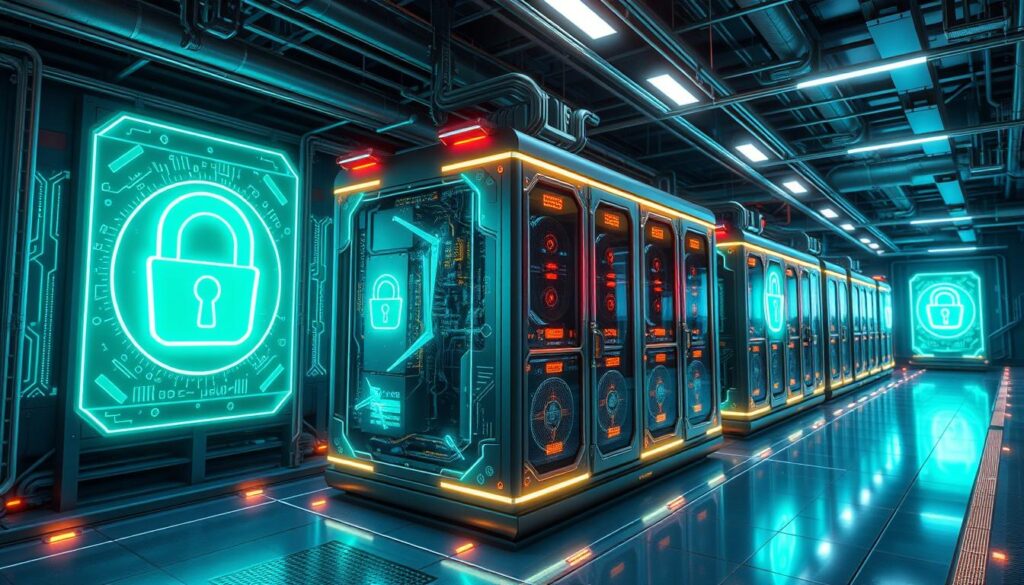
“Cryptocurrency mining attacks are the most common way attackers exploit computing resources after compromising a Google Cloud environment, according to the November 2021 Threat Horizons report.”
Staying Updated on Regulations
The world of cryptocurrency is always changing. It’s key for crypto miners to keep up with new crypto mining regulations and cryptocurrency laws. These laws can greatly impact your mining’s success and future.
Understanding Cryptocurrency Laws
Rules for crypto mining differ a lot from place to place. What’s okay in one area might be banned in another. Knowing the cryptocurrency laws in your area is vital to make sure your mining is legal.
How Regulation Impacts Mining
Regulations touch many parts of crypto mining, like taxes, energy use, and importing mining gear. Some places ban crypto mining altogether, while others help it grow. Keeping up with these changes is key to keeping your mining legal and profitable.
| Key Regulatory Aspects | Potential Impact on Mining |
|---|---|
| Taxation | Mining earnings might face income taxes, plus taxes on electricity or equipment imports. |
| Energy Consumption | Rules on energy use and emissions could stop you from running big mining rigs, mainly in strict environmental areas. |
| Hardware Importation | Rules on bringing in mining gear, like ASIC miners, can make mining harder and more expensive. |
By keeping up with crypto mining regulations and cryptocurrency laws in your area, you can keep your mining legal. This helps your business thrive in the fast-changing crypto mining world.
Optimizing Your Mining Operations
To get the most out of your crypto mining, you need to optimize your operations. This means tweaking both your hardware and software settings. By using crypto mining optimization methods, you can make your mining rig work better. This will greatly improve your mining performance.
Tweaking Settings for Better Performance
Improving your mining performance starts with tweaking your hardware settings. You can overclock your GPUs or adjust your ASIC miners’ settings. Overclocking boosts your hash rate, helping you solve problems faster and earn more.
Also, try software tweaks like custom firmware or advanced mining software. These tools help with power use, performance tracking, and algorithm adjustments. They keep up with crypto changes.
Regular Maintenance Tips
- Keep your mining rig’s fans and heatsinks clean for good airflow and to avoid overheating.
- Watch your rig’s temperature closely and use cooling solutions if needed to keep it at the right temperature.
- Always update your mining software and firmware to get the latest performance and security updates.
- Check your mining rig’s cables and connections often to find and fix any issues that could affect your mining rig maintenance.
By using these crypto mining optimization tips and sticking to a maintenance routine, you can keep your mining operations efficient. This will help you make the most of your mining performance tweaks and increase your profits.
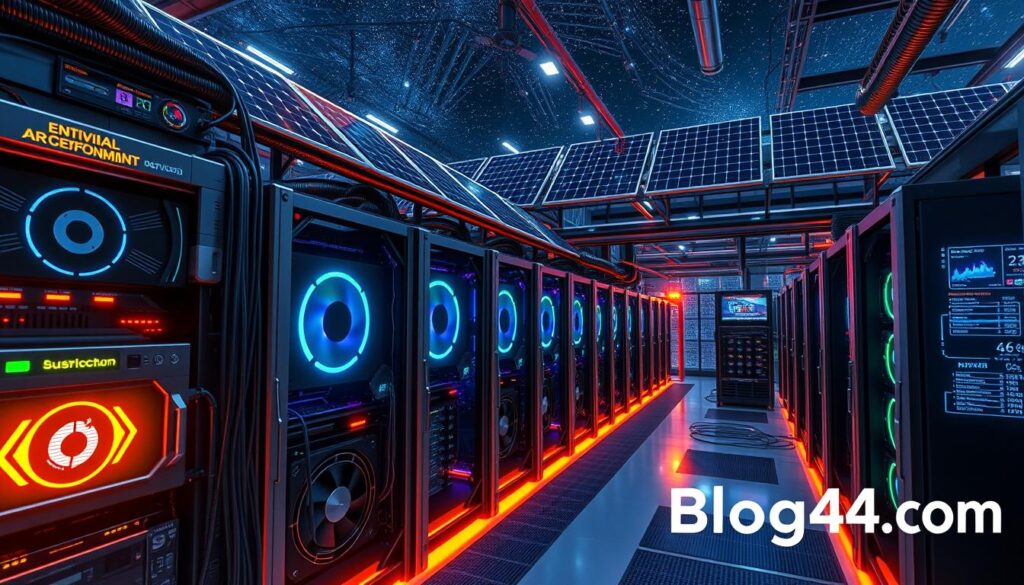
“Proper maintenance and optimization of your mining rig is key for success in crypto mining.”
Making Informed Decisions in the Market
Understanding the cryptocurrency market is key. Keep up with trends, halving events, and new tech. Tools like CoinMarketCap and TradingView offer insights into market shifts. They help you know when to buy, hold, or sell.
For profit, set up automatic sell orders at certain prices. This way, you can secure your earnings and invest again. Knowing the whole market, not just your coins, helps you see what affects your profits.
Combine your mining skills with market smarts. This way, you can make choices that fit your financial goals. Keep learning, manage your portfolio well, and stay open to new info. These habits will help you succeed in the digital asset world.
FAQ
What is crypto mining?
Crypto mining keeps cryptocurrency networks safe and running. It uses powerful computers to solve math puzzles. These puzzles confirm transactions and add them to a public ledger called the blockchain.
How does the blockchain work?
The blockchain is a system that ensures everything is transparent and secure. Mining does two important things: it secures the network and introduces new coins.
What are the different types of crypto mining?
There are several types of mining, including CPU, GPU, ASIC, cloud, and pool mining. ASIC mining is the most efficient for Bitcoin today.
What are the recommended hardware choices for crypto mining?
ASICs are the best choice for mining because they are very efficient. Popular ASIC models are the Antminer series from Bitmain and the Whatsminer series from MicroBT.
What mining software should I use?
You can use CGMiner and BFGMiner, which support many mining hardware. For beginners, EasyMiner is a good choice because it’s easy to use.
How do I set up a mining rig?
To set up a mining rig, choose the right hardware and software. Join a mining pool and set up a secure wallet. Plan carefully to avoid mistakes.
What are the benefits of joining a mining pool?
Mining pools help miners work together. This makes it easier to solve puzzles and earn rewards. It’s good for small-scale miners and offers consistent payouts.
How do I manage my electricity costs for crypto mining?
Use energy-efficient hardware and cool your systems well. Look for places with cheap electricity. Always check if your setup is efficient as prices change.
How do I monitor my mining performance?
Track your hash rate, power use, and rewards. Use mining pool software or apps like MinerStats or Awesome Miner to monitor.
How can I ensure the security of my crypto mining operation?
Use strong passwords and two-factor authentication. Keep your software updated and use antivirus programs. Hardware wallets are the safest for storing coins.
How do regulations affect crypto mining?
Laws about cryptocurrency vary by country and change often. It’s important to know the local laws to mine legally. Laws can affect mining in many ways, like taxes and energy use.
How can I optimize my crypto mining operations?
Improve your mining by fine-tuning settings and doing regular maintenance. Watch temperatures and performance to find problems early. Using better cooling can also help.
How do I make informed decisions in the crypto market?
To succeed in crypto mining, understand market trends. Make smart choices about when to buy, sell, or hold coins. Use tools like CoinMarketCap or TradingView to follow the market.


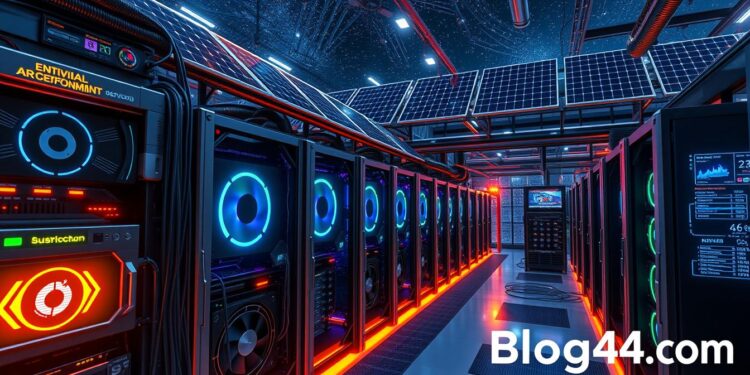















Nice